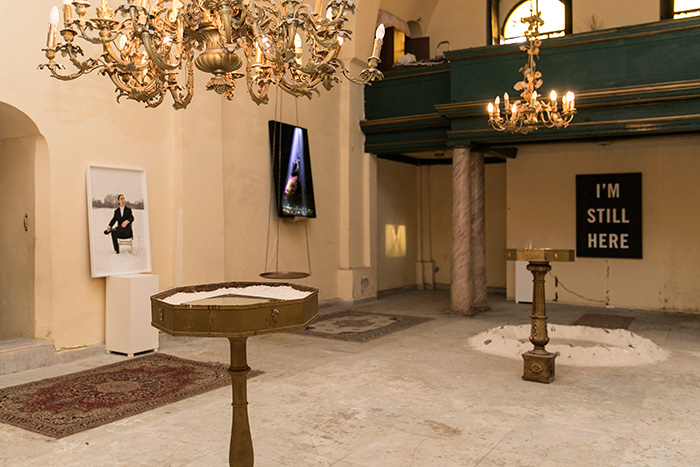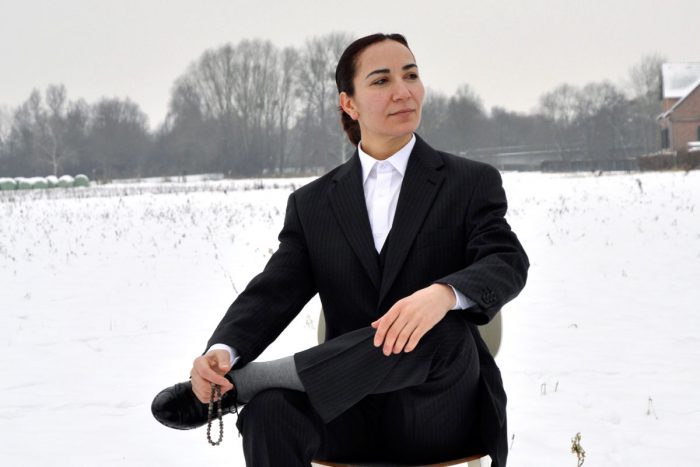What does it mean to be a transnational artist? The curators Seyhan Musaoğlu and Anna Zizlsperger focused on this question in their exhibition trans-ID, which took place in an Armenian church in Istanbul parallel to the Istanbul Biennial in the fall of 2017. They showed fourteen artists who all expressed their transnational biographies in their works, for example Şakir Gökçebağ was born in Istanbul but lives in Germany since 2006, exhibiting in Turkey as well as in many European countries. The two curators themselves can be described as citizens of the world who decided to live in Istanbul and explore the possibilities of artistic expression. They found that in this globalized, troubled world it is almost unusual to say “I was born here. I live here. I will die here.” The curators approached the nomadic realm through multi-media installations, photography, and video.What drew me in to this exhibition was that all the works had enough room to be for themselves. The location gave the time and space to experience the exhibition, far away from the noise in this busy city.
—Verena Niepel

Verena Niepel: Since the exhibition is now a while ago, is there a special moment you’d like to highlight?
Anna Zizlsperger: Maybe the moment when we visited the church – our exhibition venue – for the first time. When we decided to do an exhibition in parallel with the Istanbul Biennial—it was titled a good neighbour and dealt with the topic of borders and our notions of them—we felt that doing an exhibition about “transnationalism in contemporary art” would be an interesting idea, especially considering that Seyhan and I both have transnational backgrounds and are personally related to the topic. When we started looking for a venue, we knew that we wanted a historical building, something that embodies the essence of Istanbul as a transnational hub, which it has been for centuries, a place that made people aware of the fascinating aura of this city, which makes it such a great and exciting place to exhibit contemporary art in our opinion.
When we heard about the possibility of using the Surp Yerrortutyun Armenian Church on Istiklal Street in the heart of the city, we thought it would be a big challenge to exhibit in a church and were a bit hesitant at the beginning. We were worried about restrictions by the church in this context and also about the risk that the environment might overshadow the art works. But I still remember when we finally stood inside the church and were overwhelmed by its atmosphere, realizing that it added a whole other element to our exhibition. As an Armenian Catholic church in a majority-muslim city, it is a testament to how many religions have co-existed in this city throughout the centuries. This again is a big part of the transnational heritage of Istanbul. When we showed the space to the artists we selected they had the same feeling and everybody was very excited.

V.N.: Then the idea for the exhibition came through the biennial. Could you talk a bit more about your thoughts behind the concept of the show?
A.Z.: In the exhibition trans-ID we wanted to examine how transnational experiences affect artists’ practice and how they are manifest in the works. How does art reflect the challenges of cultural confrontation, mobility or questions of belonging?
Even before the emergence of capitalism, there was exchange between Europe and Asia, often through Istanbul. The traces of this history of exchange are visible all around the old center of the city. Located at the intersection of numerous spheres of geography and culture, Turkey is often considered to be both an eastern and a western nation. The country in itself entails diverse ranges of geography, culture and identity with a large variety of ethnic, religious and political groups. Also, the unique placement of this country contributes to Turkey’s very specific identity as a place. It was important for us to focus on the positive aspects of transnationalism in Istanbul and to move away from the general negative perception of what is going on in Turkey at the moment. We wanted to counteract the common prejudice that the art scene is dead here and remind people of the centuries-old history of this city, which still constitutes what Istanbul is today despite all the changes, especially in the last 100 years. Our exhibition venue—an Armenian Catholic church—stands for this history. While we live in difficult times in terms of politics, we still want to contradict the Western misconception that none of this multiculturalism is left in Istanbul because of the political situation. We also really wanted to show people that the local art scene still has lots of potential. Being able to make a contemporary art exhibition in a church would not be possible in Bavaria, where I am from. So it is a lot about showing that the world is not black and white and there are grey areas in between, which are worth looking at too. The show was also meant to make a call for “togetherness”, and buck the trend we observed of separating “them” and “us” and East from West.

V.N.: How did you choose the artists you wanted to show?
A.Z.: All the artists in the exhibition have a transnational background in their biographies and we selected artists who made this context visible in their artistic practice. Through my work with the exhibist magazine, I already had a large pool of artists who met this criteria and the same applies to Seyhan, who has worked with many international and Turkish artists in her Istanbul art space Space Debris. Our own transnational backgrounds were also part of our decision to choose this theme for our show. I have not been living in Germany for over 10 years, she worked and studied in France and the UK and Seyhan was born in France and studied and worked in the USA. Part of what we wanted to show is that identity is a fluid concept and how living in different countries can change your perception of identity entirely. This is also an important part of our own experience. We both feel at home and foreign here in Turkey at the same time. The artists we selected for our exhibition explore concepts of the relationship between individual biography and the biography of groups or nations, between personal and collective memory. Through their artistic practices, which carry traces of various cultures, languages, codes and transitions, they re-examine, reflect, and narrate multiple identities, geographical imaginations and experiences.
V.N.: How was the reaction of the visitors?
A.Z.: We put a lot of effort into guided tours and tried to make sure that someone talked to each visitor. We felt this was very important, particularly in a space like a church, which also has a lot of other decoration, we wanted to avoid people only looking at a few works and skipping the rest. Another reason for guiding visitors was that we wanted to emphasize the whole idea of the exhibition and to explain our idea and why it is so important to us – to emphasize the “togetherness”, which we wanted to bring across. We received very great feedback from our visitors and people were very excited about the venue. Many never had entered the church before, although it is in a very prominent position on Istiklal Street, so it was a unique experience for many of them.

V.N.: The video installation Grandmother’s Lace by Nancy Atakan was quite interesting, she made a film about the story of her mother-in-law’s family, who came to Istanbul from Thessaloniki as part of the population exchange. In what way do you think is transnational identity represented here?
A.Z.: Nancy Atakan is an American artist married to a Turkish man who has been living here for more than 20 years. Her work Grandmother’s Lace relates to the transnational background of her mother-in-law, whose family was among the 15,000 Sabbetaic people who moved to Istanbul from Thessaloniki, Greece, as a part of the 1924 population exchange. These people had to assimilate and hide their identity of origin, but tried to keep traditions like certain crafts such as characteristic lace making to remember and keep their identity. This raises questions of what constitutes identity and how it can be “handed down” through generations in exile and what the benefit of it is. Do we need a national identity to understand who we are? Many people seem to still think so today. Another interesting aspect here is that the artist seems to relate to the history of her mother-in-law, who also moved to a foreign country, but under different circumstances. It is a very poetic, personal work.

dimensions variable.
V.N.: Today, how important is the nation state when it comes to identity?
A.Z.: When we look at what is currently happening all over the world – particularly the backwards trend towards smaller national entities – it is interesting to ask what national identity has to do with pride. Could you be “proud to be Turkish?” And what does that mean? Could you be proud to be born in or to be from a certain country or is this concept of national pride outdated? In the contemporary art world, it is regarded as an outdated concept to label artists by nationality, for example. In Germany, there is this discussion about German culture and that immigrants should know and learn about it if they want to be part of the society. But then that raises the question: what does German culture consist of? What is German and is this “Germanness” a static definable concept? Suat Ögüt’s work in the exhibition, titled I have become German, deals with exactly this issue. It is interesting to ask yourself: How does someone become German, American, Turkish etc.? It might mean something completely different to people living in the same country.
And then if you apply these thoughts on the field of art – artists create their identity through their artistic practice. Does that mean that they need to free themselves of their ethnic background, their roots? Maybe sometimes we are not even aware of those roots until we live elsewhere. I think it is important to live in different countries and experience a variety of cultures to understand how similar we all are in the end when it comes down to the basics: we are all humans with pretty much the same needs, dreams and desires.
Verena Niepel (1992) is a writer and student of European Cultural Studies from the deepest forest in Bavaria, who lives in Istanbul since 2017.